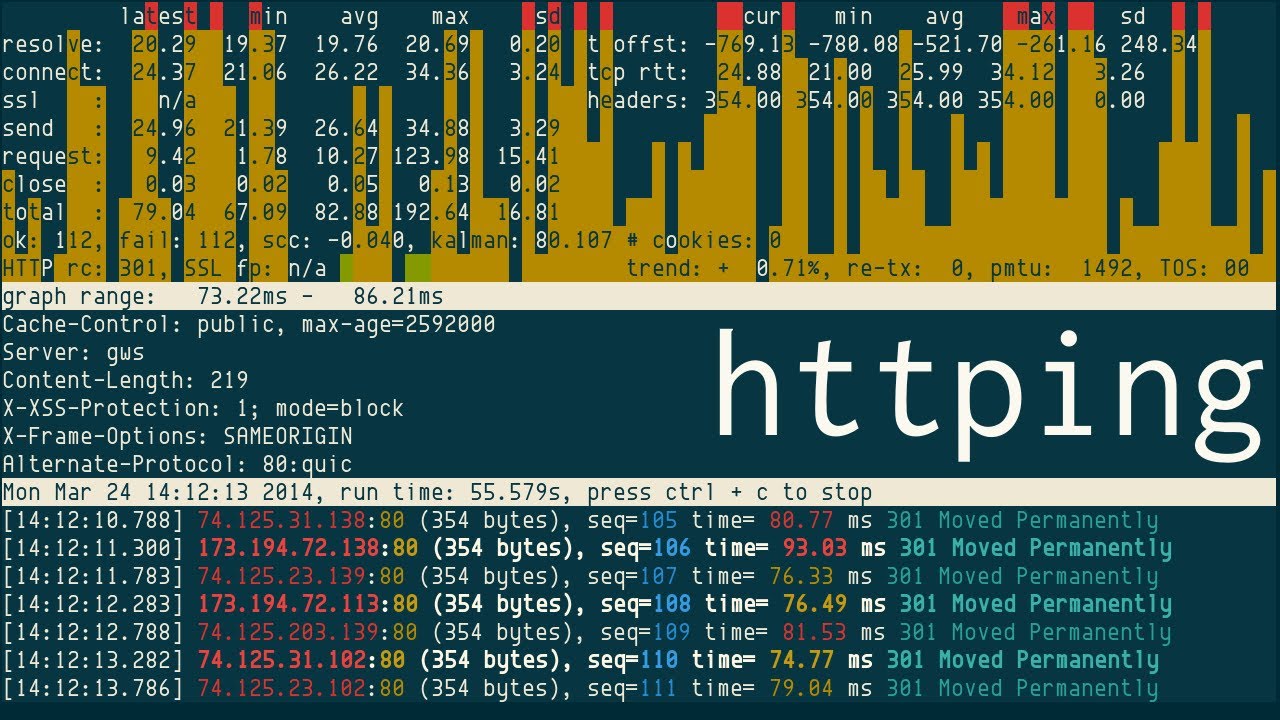1
2
3
4
5
6
7
8
9
10
11
12
13
14
15
16
17
18
19
20
21
22
23
24
25
26
27
28
29
30
31
32
33
34
35
36
37
38
39
40
41
42
43
44
45
46
47
48
49
50
51
52
53
54
55
56
57
58
59
60
61
62
63
64
65
66
67
68
69
70
71
72
73
74
75
76
77
78
79
80
81
82
83
84
85
86
87
88
89
90
91
92
93
94
95
96
97
98
99
100
101
102
| $ httping --help
HTTPing v2.4, (C) 2003-2013 folkert@vanheusden.com
* SSL support included (-l)
* ncurses interface with FFT included (-K)
* TFO (TCP fast open) support included (-F)
*** where to connect to ***
-g x / --url URL to ping (e.g. -g http://localhost/)
-h x / --hostname hostname to ping (e.g. localhost) - use either -g or -h
-p x / --port portnumber (e.g. 80) - use with -h
-6 / --ipv6 use IPv6 when resolving/connecting
-l / --use-ssl connect using SSL. pinging an https URL automatically enables this setting
*** proxy settings ***
-x x / --proxy x should be "host:port" which are the network settings of the http/https proxy server. ipv6 ip-address should be "[ip:address]:port"
-E fetch proxy settings from environment variables
--proxy-user x username for authentication against proxy
--proxy-password x password for authentication against proxy
--proxy-password-file x read password for proxy authentication from file x
-5 proxy is a socks5 server
--proxy-buster x adds "&x=[random value]" to the request URL
*** timing settings ***
-c x / --count how many times to ping
-i x / --interval delay between each ping
-t x / --timeout timeout (default: 30s)
--ai / --adaptive-interval execute pings at multiples of interval relative to start, automatically enabled in ncurses output mode
-f / --flood flood connect (no delays)
*** HTTP settings ***
-Z / --no-cache ask any proxies on the way not to cache the requests
--divert-connect connect to a different host than in the URL given
--keep-cookies return the cookies given by the HTTP server in the following request(s)
--no-host-header do not add "Host:"-line to the request headers
-Q / --persistent-connections use a persistent connection. adds a 'C' to the output if httping had to reconnect
-I x / --user-agent use 'x' for the UserAgent header
-R x / --referer use 'x' for the Referer header
--header adds an extra request-header
*** networking settings ***
--max-mtu limit the MTU size
--no-tcp-nodelay do not disable Naggle
--recv-buffer receive buffer size
--tx-buffer transmit buffer size
-r / --resolve-once resolve hostname only once (useful when pinging roundrobin DNS: also takes the first DNS lookup out of the loop so that the first measurement is also correct)
-W do not abort the program if resolving failed: keep retrying
-y x / --bind-to bind to an ip-address (and thus interface) with an optional port
-F / --tcp-fast-open "TCP fast open" (TFO), reduces the latency of TCP connects
--priority set priority of packets
--tos set TOS (type of service)
*** HTTP authentication ***
-A / --basic-auth activate ("basic") authentication
-U x / --username username for authentication
-P x / --password password for authentication
-T x read the password fom the file 'x' (replacement for -P)
*** output settings ***
-s / --show-statuscodes show statuscodes
-S / --split-time split measured time in its individual components (resolve, connect, send, etc.
--threshold-red from what ping value to show the value in red (must be bigger than yellow), only in color mode (-Y)
--threshold-yellow from what ping value to show the value in yellow
--threshold-show from what ping value to show the results
--timestamp / --ts put a timestamp before the measured values, use -v to include the date and -vv to show in microseconds
--aggregate x[,y[,z]] show an aggregate each x[/y[/z[/etc]]] seconds
-z / --show-fingerprint show fingerprint (SSL)
-v verbose mode
*** "GET" (instead of HTTP "HEAD") settings ***
-G / --get-request do a GET request instead of HEAD (read the contents of the page as well)
-b / --show-transfer-speed show transfer speed in KB/s (use with -G)
-B / --show-xfer-speed-compressed like -b but use compression if available
-L x / --data-limit limit the amount of data transferred (for -b) to 'x' (in bytes)
-X / --show-kb show the number of KB transferred (for -b)
*** output mode settings ***
-q / --quiet quiet, only returncode
-m / --parseable-output give machine parseable output (see also -o and -e)
-M json output, cannot be combined with -m
-o rc,rc,... / --ok-result-codes what http results codes indicate 'ok' comma seperated WITHOUT spaces inbetween default is 200, use with -e
-e x / --result-string string to display when http result code doesn't match
-n warn,crit / --nagios-mode-1 / --nagios-mode-2 Nagios-mode: return 1 when avg. response time >= warn, 2 if >= crit, otherwhise return 0
-N x Nagios mode 2: return 0 when all fine, 'x' when anything failes
-C cookie=value / --cookie add a cookie to the request
-Y / --colors add colors
-a / --audible-ping audible ping
*** GUI/ncurses mode settings ***
-K / --ncurses / --gui ncurses/GUI mode
--draw-phase draw phase (fourier transform) in gui
--slow-log when the duration is x or more, show ping line in the slow log window (the middle window)
--graph-limit x do not scale to values above x
-D / --no-graph do not show graphs (in ncurses/GUI mode)
-V / --version show the version
Example:
httping Mike-Master-01 -Y -s -Z
Welcome to the new HTTPing version 2.4!
Did you know that with -K you can start a fullscreen GUI version with nice graphs and lots more information? And that you can disable the moving graphs with -D?
|
